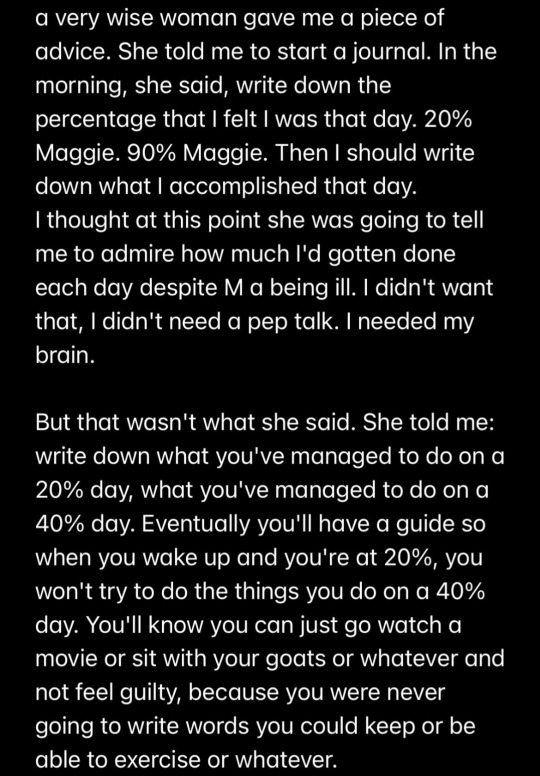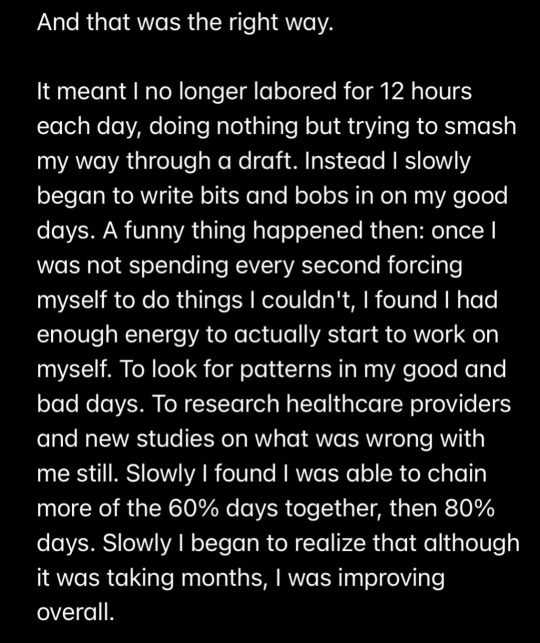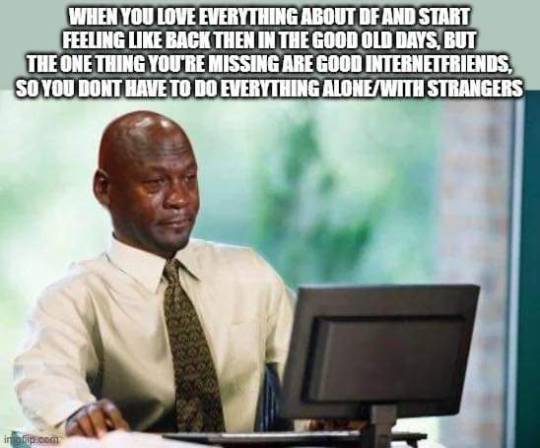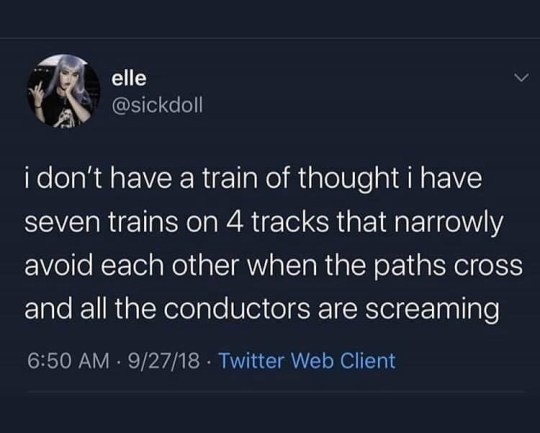OOC space for the mun. Parent blog to IC Warcraft Blogs: @vcloudbreaker, @anaralar, @gloamchild, @telendi, @shaedai, @oriannae, @dreadguard-dolene, @arkara-starling, @gwynyfyr, @ivenya, @dunelord @redroxwra , @kal-evenlight @petrette @kaelinde @severra-firefinch , @mournaria , @lady-cayleen , @declaryn
Don't wanna be here? Send us removal request.
Text
OOC Activity Check!
Who's still active out there in WRA land?
10 notes
·
View notes
Note
For archery, is it easier to hit a moving target while standing still or hit a still target while moving?
This one's a little more complicated than it sounds. There's basically two parts to this. Tracking and leading a target moving at a consistent speed isn't too bad, but if it's moving erratically, hitting it can become an absolute nightmare.
Generally speaking, it's easier to hit a stationary target while moving, though, again, if your movement is erratic, and you don't control it (for example, if you're on some vehicle, like a wagon, or pickup truck, and someone else is driving), that's not as easy. If you have control over your movement, then you'd need to split your attention between driving, or riding, and aiming), which is harder than you'd expect. Even just walking with a drawn bow requires splitting your attention in awkward ways. It's not impossible, but it does require more, “mental bandwidth,” than you'd expect. In contrast, keeping a bead on a stationary target while walking with a crossbow (or gun) is pretty easy. It's the bow itself that makes this more difficult. Just to be clear, I have a lot of respect for mounted archers, it sounds simple enough, but there's a lot more going on there than you might expect.
Pausing movement to fire on a stationary target, and then resuming movement is about as easy as it ever gets. In a lot of cases, when you have moving archers, this is what will actually happen. They'll stop moving (or at least, severely slow), aim, fire, and then resume motion. But, technically this is out of scope for your question, so as an answer, it's kinda cheating, but if it's an option, it is the best one for your mobile archers, including if they're mounted.
-Starke
This blog is supported through Patreon. Patrons get access to new posts three days early, and direct access to us through Discord. If you’re already a Patron, thank you. If you’d like to support us, please consider becoming a Patron.
289 notes
·
View notes
Text
Writing a Story from Start to Finish - Guide
I see you guys in the tags and reblogs talking a lot about how you have a desire to write, but have no clue what to write about, or where to even start figuring that out. While starting any project can be incredibly daunting, I wanted to put together a little guide to hopefully make it a bit more accessible. Be warned, this will probably be a long post.
Step 1: Form an idea
All writing begins with this: an idea. Ideas can start as small as an object, or as big as a world or cast of characters. What’s important is that your idea genuinely interests you, and makes you want to explore it more.
There are a million ways to gain inspiration for ideas, but my favourite method is a sort of brainstorm/mind map of all the little and big things you find interesting. Any tropes, characters, places, concepts, objects, animals, other stories, etc. you love—write them down. Then, start connecting the pieces. Each connection is one concept or idea you could explore further.
If this doesn’t work for you, try using some writing prompts or check out 15 ways to spark new ideas.
If you are a planner, proceed to Step 2. If you are a pantser, skip to step 7.
Step 2: Create your Protagonist
Now that you have a sort of concept or inspiration to work off of, you need your main character. There are about as many ways to create characters as there are characters themselves, and each method is going to work better or worse for every writer.
At the barest minimum, all your protagonist needs is a Goal to work towards, a Reason for wanting it, and a Flaw that keeps them from having it right away.
These three things can form a baseline character. Consider what the thing they want, why they want it, and what’s keeping from it says about them as a person.
Rapunzel (from Disney’s Tangled) wants to see the ‘floating lights’ on her birthday. She wants to because she believes she will learn more about herself through seeing them. Her fear over disappointing and disobeying her ‘mother’ keeps her from it.
My favourite character creation technique is actually Here—it takes you through creating character in order to create story.
If that one doesn’t work for you, try this one. It is more focused on defining traits and figuring out the personality of the character first.
Step 3: Your Plot is your Protagonist’s Arc
As stated in the character creation technique I shared in Step 2, character is plot. By that I mean, the character’s journey is the plot of the story. We’re here to see the protagonist transform because of the circumstances incited in the beginning.
So to form a plot, we need to know who the character is at the beginning, and what they need to learn by the end.
Your character’s arc is A but B so C:
A – your character and their flaw
B – The conflict they go through
C – how they change
“Obsessed with success, Jenny Beech works tirelessly to earn the approval of her strict parents and graduate top of her class, but when the new girl in town pulls her into a whole new world of excitement and fun, she must stand up for herself against her impossible standards and learn how to be a teen again.”
This one sentence has everything we need to know about this story and character: “Obsessed with success (character trait/flaw), Jenny Beech works tirelessly to earn the approval of her strict parents and graduate top of her class (goal), but when the new girl in town pulls her into a new world of excitement and fun (conflict), she must stand up for herself against her impossible standards and learn how to be a teen again (change).”
If you have these three things, congratulations! You already have a story. If you’d like, you may begin writing it now (skip to step 8). Or…
Step 4: Theme
I did a whole post on theme you should check out here. Essentially, the big takeaway is that your theme is a lesson to impart to the readers—which means it is not a question, it is an answer.
For the example given above, our theme would likely be something like, “Teens need to balance their additional responsibilities as they mature into young adults with the joy of being young and having fun.” Or, “Friends and a close social network is more important than having the best grades.” Or, “It’s important to take frequent time away from work in order to maintain one’s humanity.” Etc. Etc.
Theme is conveyed through what your characters need to do to succeed (or what they do that causes their failure). If Jenny lets loose and suffers consequences for it in the end, we’re saying that she should have stuck to her studies rather than letting herself have fun. If she lets loose and is rewarded with a greater relationship with herself and her parents, we’re saying that was the correct thing to do.
Step 5: Outlining
Now that we have a plot and a theme, we can outline our story. An outline is like a roadmap of what you’re writing. It can be as specific or broad as you want. My outlines tend to follow this structure, and I improvise the little stuff in between, but if you need to get all your ideas within your outline, that’s good too!
Just make sure your notes make sense to you so when you need to know where to go next, you have a handy tool just for that.
Step 6: Worldbuilding
Worldbuilding is probably where you’ll spend the most time because there’s just so much. However, I also find it one of the most fun parts. The minimal thing you need to know is your world’s normal, and how that normal is disrupted in the inciting incident.
Jenny’s normal is school work and trying to impress her parents. The disruption is the new girl in town.
Rapunzel’s normal is the tower and her hobbies. The disruption is Flynn breaking in.
I did a more in-depth post on worldbuilding here, but the basics is just ask questions, explore consequences, and do plenty of research.
Which brings us to…
Step 7: Research
This can also be done after your first draft, but can’t be skipped entirely. It’s important when trying to convey experiences that may not be wholly your own, or unique perspectives, that you understand the context behind those things in the real world.
Once again, ask questions, talk to people, and remain open to what you find.
Step 8: We can start writing now
Now that you have all your planning ducks in a row (or have a good inspiration to jump from) it’s time to start writing! Either go from the outline you built, or just try out scenes. I have some tips for actually writing the dang thing that I’ll put here:
Let me know how your writing goes, good luck!
3K notes
·
View notes
Text


I've seen this before, but it's been years and it just came across my Twitter in its dying days. The words are from a favorite author of mine, Maggie Stiefvater, and they are the words I most need to hear when it comes to dealing with chronic pain and illness. I didn't need this the first time I saw it, six years ago. I need it now. Maybe you do, too.
117K notes
·
View notes
Text
Maintaining a Consistent Tone
Tone is deceptively difficult to maintain because after we set up all the important worldbuilding stuff at the beginning, it can be easy to forget to reinforce those details that ultimately create the tone of our piece.
Tone is comprised of:
Voice
Subject matter
Core emotions evoked by characters/world/events/etc.
It’s important to maintain a consistent tone (or an intentionally evolving one) across your entire story as it acts as the background to what’s happening and is part of the hook readers are latching onto at the beginning. Imagine if Wednesday the show dropped the creepy act halfway through and just let the events play out amidst a normal, realistic backdrop. That’s not why we started the show, and so we’d likely not finish it.
To keep up the tone we establish in the beginning, you’re going to want to single out the key words, details, and moments that did that work for you. Word choices, character moments, introductions to settings, etc.
“creaked”, “whined” or “croaked” all mean the same but create a slightly different feeling--horror, drama, fantasy.
Do characters use a flashlight or a lantern or their phone light? Are there segments of silent introspection, or funny banter and quips?
Does the forest loom or does it blanket?
The details and words you pick out here should be maintained across the entire piece. It’s not enough to mention the first time they need a light they pull out a lantern, you have to make sure that detail keeps coming up all the way through the middle and the end too.
As well, these word choices impact the voice you are using, so sticking to the ‘vocab’ of your world is important in creating that tone (and a better overall flow).
Any other ways you can think of? Let me know!
1K notes
·
View notes
Text
“Do not engage….just keep scrolling.”
I remind myself after being back on tumblr for 23 minutes 😭
13 notes
·
View notes
Text

can we start a club for aging millennials who went entirely too hard as guild masters in WoW, who now experience actual nausea when confronted with the idea of ever running a guild, free company or running any kind of RP group ever again? like where are we hanging out these days?
43 notes
·
View notes
Text
Just leaving this WoW Lore Timeline vs Wow Retail Timeline here for my own reference, don't mind my aggravated ravings
Concession: Exact Azerothian dates are unknown, only that entire expansions happened in the Azerothian year(s) expressed Vanilla: Year 25 Nov 23 2004 784 days Or 2 years, 1 month, 24 days excluding the end date. TIME LOST - 1 year, 1 month, 24 days BC: Year 26 Jan 16 2007 The duration is 667 days Or 1 year, 9 months, 28 days excluding the end date. TIME LOST - 9 months, 28 days Wrath: Year 27 Nov 13 2008 The duration is 754 days, 0 hours, 0 minutes and 0 seconds Or 2 years, 24 days excluding the end date. TIME LOST - 1 year, 24 days Cata: Years 28 & 29 Dec 7 2010 The duration is 660 days, 0 hours, 0 minutes and 0 seconds Or 1 year, 9 months, 20 days excluding the end date. TIME GAINED - 2 months, 13 days excluding the end date. Mop: Year 30 Sept 27 2012 The duration is 777 days, 0 hours, 0 minutes and 0 seconds Or 2 years, 1 month, 17 days excluding the end date. TIME LOST - 1 year, 1 month, 17 days WoD: Year 31 Nov 13 2014 The duration is 656 days, 0 hours, 0 minutes and 0 seconds Or 1 year, 9 months, 17 days excluding the end date. TIME LOST - 9 months, 17 days Legion: Year 32 Aug 30 2016 The duration is 714 days, 0 hours, 0 minutes and 0 seconds Or 1 year, 11 months, 15 days excluding the end date. TIME LOST - 11 months, 15 days BfA: Years 33 & 34 August 14 2018 The duration is 832 days, 0 hours, 0 minutes and 0 seconds Or 2 years, 3 months, 9 days excluding the end date. TIME LOST - 3 months, 9 days Shadowlands: Years 35&36 Nov 23 2020 Dragonflight: Year 40 Dec 2022??
TOTAL TIME LOST: 6 YEARS, 2 MONTHS, 3 DAYS Time GAIN expected between SL release and DF release : 2 months and change APPROXIMATE TIME of Vanilla RP character existence LOST, 6 Years (other losses calculable with above dates) APPROXIMATE TIME TO ADD TO RP CHARACTER EXISTENCE -SINCE- THE END OF SHADOWLANDS - BEFORE- DF RELEASE DATE: 3 years and UNKNOWN change IN MONTHS
Vanilla RolePlayer will have to adjust for 6 years lost or somehow create a 3 year net loss adjustment, instead.
1 note
·
View note
Text
“Why complicate life? Missing somebody? - Call. Wanna meet up? - Invite. Wanna be understood? - Explain. Have questions? - Ask. Don’t like something? - Say it. Like something? - State it. Want something? Ask for it. Love someone? - Tell it. We just have one life. Keep it simple.”
— Unknown
525 notes
·
View notes








